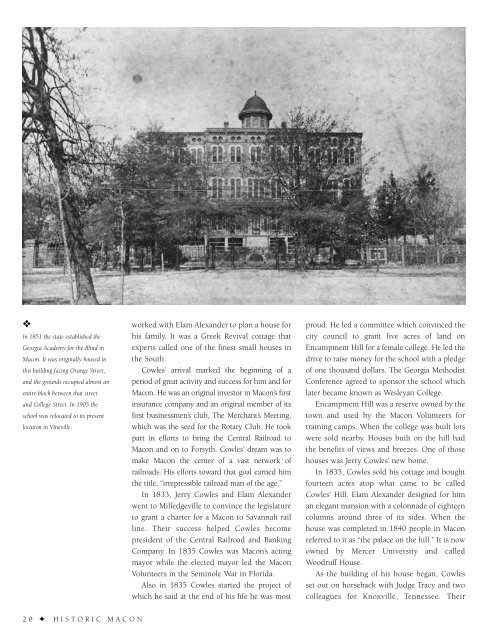Historic Macon
An illustrated history of the city of Macon, paired with the histories of companies, families and organizations that make the region great.
An illustrated history of the city of Macon, paired with the histories of companies, families and organizations that make the region great.
Create successful ePaper yourself
Turn your PDF publications into a flip-book with our unique Google optimized e-Paper software.
❖<br />
In 1851 the state established the<br />
Georgia Academy for the Blind in<br />
<strong>Macon</strong>. It was originally housed in<br />
this building facing Orange Street,<br />
and the grounds occupied almost an<br />
entire block between that street<br />
and College Street. In 1905 the<br />
school was relocated to its present<br />
location in Vineville.<br />
worked with Elam Alexander to plan a house for<br />
his family. It was a Greek Revival cottage that<br />
experts called one of the finest small houses in<br />
the South.<br />
Cowles’ arrival marked the beginning of a<br />
period of great activity and success for him and for<br />
<strong>Macon</strong>. He was an original investor in <strong>Macon</strong>’s first<br />
insurance company and an original member of its<br />
first businessmen’s club, The Merchant’s Meeting,<br />
which was the seed for the Rotary Club. He took<br />
part in efforts to bring the Central Railroad to<br />
<strong>Macon</strong> and on to Forsyth. Cowles’ dream was to<br />
make <strong>Macon</strong> the center of a vast network of<br />
railroads. His efforts toward that goal earned him<br />
the title, “irrepressible railroad man of the age.”<br />
In 1833, Jerry Cowles and Elam Alexander<br />
went to Milledgeville to convince the legislature<br />
to grant a charter for a <strong>Macon</strong> to Savannah rail<br />
line. Their success helped Cowles become<br />
president of the Central Railroad and Banking<br />
Company. In 1835 Cowles was <strong>Macon</strong>’s acting<br />
mayor while the elected mayor led the <strong>Macon</strong><br />
Volunteers in the Seminole War in Florida.<br />
Also in 1835 Cowles started the project of<br />
which he said at the end of his life he was most<br />
proud. He led a committee which convinced the<br />
city council to grant five acres of land on<br />
Encampment Hill for a female college. He led the<br />
drive to raise money for the school with a pledge<br />
of one thousand dollars. The Georgia Methodist<br />
Conference agreed to sponsor the school which<br />
later became known as Wesleyan College.<br />
Encampment Hill was a reserve owned by the<br />
town and used by the <strong>Macon</strong> Volunteers for<br />
training camps. When the college was built lots<br />
were sold nearby. Houses built on the hill had<br />
the benefits of views and breezes. One of those<br />
houses was Jerry Cowles’ new home.<br />
In 1835, Cowles sold his cottage and bought<br />
fourteen acres atop what came to be called<br />
Cowles’ Hill. Elam Alexander designed for him<br />
an elegant mansion with a colonnade of eighteen<br />
columns around three of its sides. When the<br />
house was completed in 1840 people in <strong>Macon</strong><br />
referred to it as “the palace on the hill.” It is now<br />
owned by Mercer University and called<br />
Woodruff House.<br />
As the building of his house began, Cowles<br />
set out on horseback with Judge Tracy and two<br />
colleagues for Knoxville, Tennessee. Their<br />
20 ✦ HISTORIC MACON
















